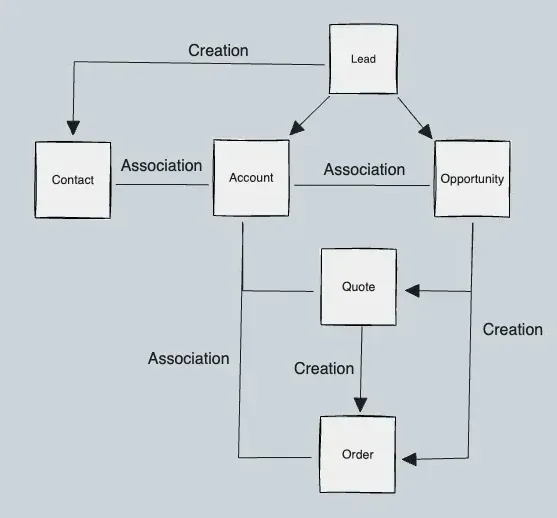Salesforce Sales Cloud stands at the forefront of CRM solutions, offering businesses a comprehensive platform to enhance their sales operations. It streamlines the sales process, ensuring that potential leads are not only captured but also effectively converted into profitable relationships. By providing a detailed overview of each stage in the sales lifecycle, Sales Cloud helps businesses manage their sales funnel with precision.
Capture Initial Lead Data
The journey begins with the Lead object, designed to capture and track potential leads. At this initial stage, businesses gather numerous pieces of information about prospective prospects, laying the groundwork for an effective follow-up strategry to convert these leads into an opportunity.
Conversion of Leads
The lead conversion process marks a the transition where leads are converted into three key objects: Account, Contact, and Opportunity. This phase is pivotal as it signifies the potential lead’s interest in becoming a customer, turning data into actionable sales opportunities.
Account Object: Represents the customer’s company or organization, serving as a repository for all interactions and transactions.
Contact Object: Personifies the individual customer contacts within a given customer Account, ensuring personalized communication and relationship building.
Opportunity Object: Manages potential sales and deals, providing a snapshot of the possible revenue and enabling sales teams to prioritize their efforts into keystone accounts.
Tracking Opportunity Progress
Sales Cloud enables tracking the progression of opportunities through various stages, such as qualification, negotiation, and closure. This visibility ensures that sales teams can strategically allocate their resources and efforts where they will have maximum effect.
Qualification: This stage is all about identifying potential opportunities that align with your business capabilities and customer needs. It’s a critical filter to ensure that sales efforts are focused on leads with genuine potential for conversion, optimizing resource allocation right from the start.
Negotiation: At this juncture, the dance of give-and-take occurs, where pricing, terms, and conditions are discussed in detail. It’s a pivotal phase where sales teams leverage their skills and tools to shape the offer in a way that meets both parties’ expectations, inching closer to a win-win outcome.
Closure: The final leap where agreements are signed and deals are sealed. This stage represents the culmination of the sales process, where meticulous efforts are rewarded with a successful transaction. It’s a moment of validation for the strategies employed, setting the stage for future opportunities and fostering long-term relationships.Product Interest
Quote Generation (Optional)
Integrating the Quote object into the Sales Cloud lifecycle streamlines the transition from understanding customer needs to creating precise, customized proposals. By using the Quote object, sales teams can generate detailed quotes based on the specific products and services a customer is interested in, ensuring the proposal aligns with their requirements. This step not only personalizes the sales experience but also formalizes the offer, making it a crucial component in moving towards deal closure. The ability to create and adjust quotes easily allows for clear communication and negotiation, facilitating a smoother path to sales success.
Product Catalog and Pricing
The Product2 object, along with PriceBook and PriceBookEntry objects, manage the catalog items and their pricing strategies. This ensures that sales teams can offer competitive and accurate pricing for products and services.
Order Creation and Fulfillment
Upon successfully closing a deal, the Order object comes into play, transitioning from sales to fulfillment. It captures the essence of the customer’s purchase, detailing the products involved through the OrderItem object which in turn associates with a specific Product2 object.
Salesforce Order Management (Optional)
Salesforce Order Management represents an advanced option for businesses aiming to elevate their operational capabilities beyond the foundational offerings. Integrating Salesforce Order Management with Sales Cloud facilitates a comprehensive solution that spans the entire process from lead acquisition to fulfillment. This integration provides businesses with enhanced control and granularity over the order fulfillment process. Additionally, Salesforce Order Management introduces a variety of improvements, including streamlined operations, improved customer service capabilities, and better inventory management. By leveraging these enhancements, businesses can achieve a more efficient, transparent, and customer-focused fulfillment process, thereby ensuring that every step from the initial lead to the final delivery is managed with precision and care. This holistic approach not only optimizes operational efficiency but also significantly enhances customer satisfaction, positioning businesses for greater success in a competitive marketplace.
In Closing
The Salesforce Sales Cloud lifecycle offers a holistic view of the sales process, from lead capture to order fulfillment. By leveraging the interconnected Salesforce objects, businesses can ensure a seamless transition between each stage, enhancing their sales efficiency and customer relationships. Understanding this lifecycle is crucial for businesses looking to optimize their sales operations and drive growth through strategic sales management.
The Sales Cloud Lifecycle





